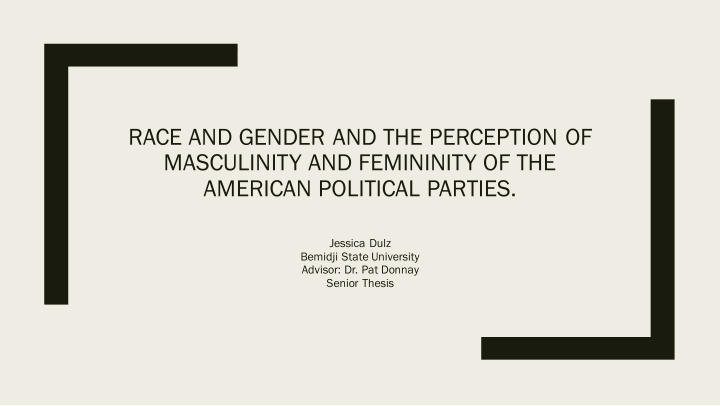



RACE AND GENDER AND THE PERCEPTION OF MASCULINITY AND FEMININITY OF THE AMERICAN POLITICAL PARTIES. Jessica Dulz Bemidji State University Advisor: Dr. Pat Donnay Senior Thesis
Introduction ■ Why did I choose this topic? – Psychology and Political Science Background – Women’s rights as well as race are trending issues in politics – Current presidential candidate campaign
Political Party Identification ■ Party Identification can be defined as “a long term psychological attachment to a political party” ( Weinschenk, 2010) ■ changing internal conflicts going on within each political party results in some party candidates shifting from the norm of their parties (Arroyo, 2004).
Gender Stereotypes Feminine Masculine ■ compassionate, devoted to others, ■ active, independent, decisive, emotional, gentle, submissive, and aggressive, tough, hardworking and egalitarian hierarchal Another causal link to the gender differences are the differing social roles and responsibilities than men and women have. However these differences are fading in today’s society
Hypothesis 1 – Political Party ■ Democrats will have strong leanings toward feminine traits ■ Republicans will have strong leanings toward masculine traits Winter, N. J., & G. (2010) Ducat, S. J., & Gates, T. J. (2006) McIlwain, C. D. (2004) Campbell, A., Converse, P., Miller, W., & Stokes, D. (1960)
Hypothesis 2 – Race ■ Among whites the results will be similar to previous studies which found Republicans to be much more favorable of masculine traits and Democrats to favor feminine traits. ■ I anticipate my results to show that African American individuals do not apply gender aspects of masculinity and femininity nearly as much as white individuals
American National Election Studies ■ 2012 ANES ■ Frequency ■ Variables ■ Cross Tabulation Report – Abortion ■ 3 – 3 Factorial ANOVA – Women’s Roles – Child Traits Choices
F Sig. Women Working Gender 2.192 .139 Race .019 .890 Party ID 9.056 .003 Gender + Race .928 .336 Gender + ID .023 .880 Race + ID 1.187 .276 Gender + Race + ID .313 .576 < Ronald Fisher
F Sig. Abortion Party ID 39.862 .000 Gender .177 .674 respond_race .150 .699 Race .373 .541 ID + Race 10.574 .001 Gender + Race .134 .714 ID + Gender + Race .195 .659
F Sig. Independent VS. Respectful Party ID 5.986 .014 Gender 1.720 .190 Race 4.307 .038 ID + Gender 2.594 .107 ID + Race 2.462 .117 Gender + Race 1.321 .251 ID + Gender + Race 2.093 .148 F Sig. Considerate VS Well-Behaved Gender .628 .428 Race 22.555 .000 Party ID .143 .705 Gender + Race 1.768 .184 Gender + ID .051 .822 Race + ID 1.968 .161 Gender + Race + ID .057 .812
F Sig. Curiosity VS. Manners Gender 2.136 .144 Race 12.293 .000 Party ID .279 .597 Gender + Race .000 .993 Gender + ID .013 .909 Race + ID 9.551 .002 Gender + Race + ID .002 .969
F Sig. Obedience VS Self-Reliance Gender 1.636 .201 Race 9.844 .002 Party ID 2.531 .112 Gender + Race .747 .387 Gender + ID .407 .524 Race + ID 4.814 .028 Gender + Race + ID 1.020 .313
Results Independent/ respectful - No interactions Curiosity/ manners - Interaction between ID and Race Obedience/ reliance - Interaction between ID and Race Considerate/ well-behaved - No Interactions Abortion - Interaction between ID and Race
Recommend
More recommend